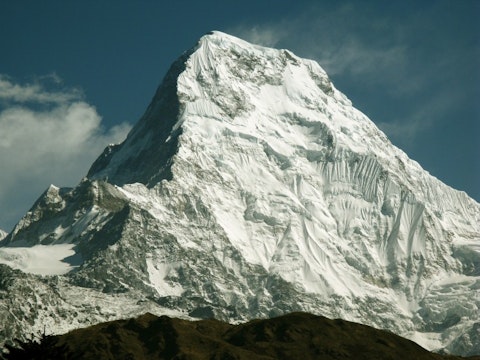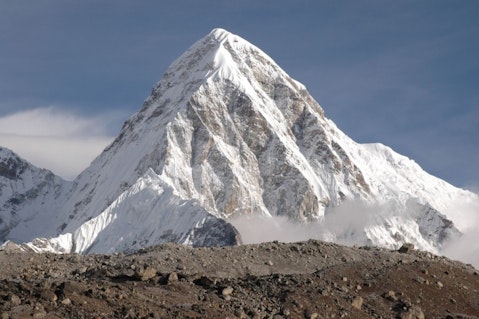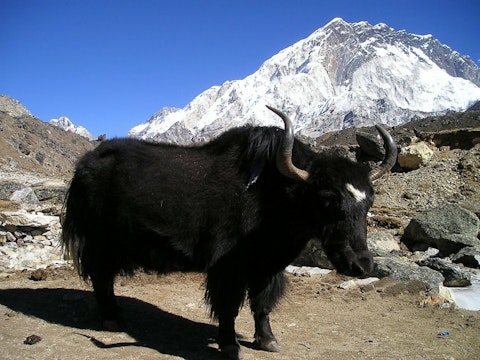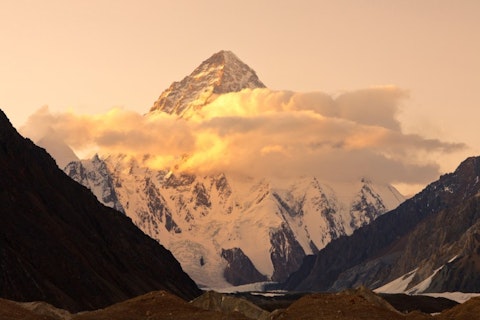The Earth’s diverse, ever-changing landscape is what draws to many of us to develop an interest in geology, and I’m sure I’m not alone in wanting to discover the 11 tallest mountains in the world. The question is not a simple as it sounds: first, we need to define what we mean by ‘tallest’. Most of us have heard that Mount Everest stands shoulders above any other structure or formation above the earth, and when we consider altitude, this is true: because the base of Everest begins relatively close to sea-level, the majority of the peak is above water, meaning it rises to the highest altitude in the world. We will use altitude to define the height, as this allows us a greater degree of accuracy. You may read that Mauna Kea, a volcano on Hawaii, is classed as the tallest mountain: this is because the majority of the volcano is below sea-level; only 13,796 feet is out of the water, compared to the 33,465 feet which is below the sea! However, as much of what lurks at the bottom of the ocean remains a mystery to us mere mortals, measurements that begin below sea level are notoriously inaccurate. For reasons of precision, therefore, we will define ‘tallest’ in terms of ‘highest altitude above sea-level’. This is how we experience ‘tallest’, and so the tallest mountains to climb are those that tower high above sea-level.

Dchauy/Shutterstock.com
You might be surprised to discover that all the mountains making our list of the 11 tallest mountains in the world are all found relatively close to each other in Asia. All eleven fall in the ranges of the Greater Himalayas and the Karakoram, which despite being adjoined in geological terms, politically speaking they are considered separate. Whatever the distinction, if climbing one of the world’s tallest peaks is your ambition, you should head straight to the mountains of northern Asia! And, if mountain biking is more of your choice for outdoor sport you should definitely check out our article on the top 13 most expensive mountain bikes in the world.
Now, let’s get back and discover those tallest mountains in the world.
11. Gasherbrum I
Elevation: 8,078 meters
Also known as the Hidden Peak, Gasherbrum I is located on the border between Pakistan and China. Not to be confused with Gasherbrum II, it is the second highest peak in the Karakoram mountain range, the area with the most glaciers outside of the polar regions. The name is said to arise from ‘rgasha brum’ which means ‘beautiful mountain’ in the Balti language. The first people to climb to the summit were Pete Schoening and Andy Kauffman, back in 1958.

10. Annapurna
Elevation: 8,091 meters
Annapurna is located in the Himalayas of Nepal, and this beautiful towering peak was previously known as Morshiadi. The name ‘Annapurna’ is a Sanskrit word which can be translated as ‘Goddess of the Harvests’. Literally, it means ‘full of food’, and perhaps this is one of the reasons it was the first of the 8,000m giants to be conquered – by an expedition led by Maurice Herzog – back in 1950. Unusually, especially for that time, the ascent took place without the use of oxygen tanks, and Herzog received the 1950 Société de Géographie’s Gold Medal for his achievement.

9. Nanga Parbat
Elevation: 8,126 meters
Nanga Parbat, another of the Himalayan giants, is the most westerly peak in our list. It is made remarkable one of its three vast faces: the Rupal face, which is the highest mountain face in the world. The 19th-century mountaineer Albert Mummery described the Rupal face as ‘ the most terrifying faces of a mountain I have ever seen’. It is widely considered to be the third most dangerous mountain in the world (keep on reading to find out which peaks are even more treacherous), and has a death rate of over 22%. 31 climbers died before it was successfully conquered in 1953, by Austrian climber Hermann Buhl.

8. Manaslu
Elevation: 8,156 meters
Manaslu, located in Nepal’s Himalayas, is 40 miles east of Annapurna. Its name means ‘mountain of the spirit’ in Sanskrit. Manaslu is hit by more avalanches than some of the other peaks in our list, and in 2012 eleven climbers were killed in an avalanche disaster. Avalanches, as well as monsoon conditions, were behind several failed attempts at climbing the peak in the early 1950s; no-one was successful in reaching the top until 1956 when a local Sherpa finally made it. Nobody else achieved his feat until 1971, and the first American to conquer Manaslu was not until Charlie Mace’s success in 1997.

7. Dhaulagiri
Elevation: 8,167 meters
When Nepal’s Dhaulagiri was first discovered back in 1808, it was considered to be the world’s tallest mountain. Its name, which is of Sanskrit origin, means ‘White Mountain’, and at least 62 climbers have died in their attempts to reach the summit. The first successful ascent of this towering peak was not made until 1960, by a team of Swiss explorers.

6. Cho Oyu
Elevation: 8,188 meters
Despite its lofty heights, Cho Oyu is often thought of as the easiest 8,000-meter peaks to conquer. Many climbers intent on scaling the 8,000-meter mountains choose this summit as their first. Cho Oyu is located on the border between China and Nepal, and its name means ‘Turquoise Goddess’. Sir Edmund Hillary, the eminent New Zealand mountaineer and explorer, recounts his experience of Cho Oyu in his autobiography. He describes the failed attempt of 1952, which he’d planned as a way of trying out the oxygen equipment in preparation for the following year’s Everest attempt, as largely down to the threat of Chinese troops, not to mention a warning of an ice avalanche. Cho Oyu was climbed successfully in 1954, and since then, ‘only’ 43 fatalities have occurred – one of the lowest tolls for the mountains in our list of the 11 tallest mountains in the world.

5. Makalu
Elevation: 8,484 meters
Almost 300 meters taller than number 6 on our list, Makalu is an impressive giant of the Himalayas. It stands 10 miles southeast of Mount Everest, and its name comes from the Sanskrit Maha-Kala, ‘big black’. It certainly is big, and its almost perfect pyramid shape, with four sharp ridges, make the ‘giant’ all the more impressive to take in. Of the first 16 attempts to conquer the tricky summit, a mere 5 proved successful (the first in 1955), and to date, there have only been 206 victorious ascents, with a fatality rate of over 10 percent. It is rightly considered one of the hardest of the 8,000-meter peaks to climb.

muratcankaragoz/Shutterstock.com
4. Lhotse
Elevation: 8,516 meters
As only 42 climbers have been successful in climbing Lhotse, and 21 others have died in their attempts, the odds are not good. This mountain is linked to Everest by the South Col, which is Everest’s highest camp. Reaching the South Col can only be done by scrambling over a 4,000-meter ice-covered face. Perhaps the difficulty factor can explain why it was not until 1956 when two Swiss explorers (Ernst Reiss and Fritz Luchsinger) finally managed to conquer this peak – and the purpose of this expedition was only as an alternative route to reaching Everest’s summit. Not one for the faint-hearted!

3. Kangchenjunga
Elevation: 8,586 meters
This Himalayan giant stands at the border of northern India and eastern Nepal, around 50 miles from the Indian town Darjeeling. The name is thought to mean ‘five treasures of snow’, as the mountain has five distinct peaks (its main peak, unsurprisingly called ‘Kangchenjunga Main’, is the one we discuss here). Until the mid-1800s, Kangchenjunga was considered to be the world’s tallest mountain, and it was not until results from India’s comprehensive Great Trigonometrical Survey came through that it was declared ‘merely’ the third-tallest. The area surrounding Kangchenjunga has long been associated with mythical beings, and back in 1925, a British expedition examining the geology of the region claimed to have sighted a ‘bipedal creature’, spotting 15 footprints in the snow. Locals assured them they had seen the ‘Kangchenjunga Demon’, although some claim it is ‘proof’ of the yeti. Perhaps it was merely a Himalayan yak, as seen below…

2. K2 (Mount Godwin Austin)
Elevation: 8,610 meters
K2 is the second tallest mountain in the world and has often been dubbed ‘savage mountain’, because of the risks involved with its ascent. Indeed, while there have been 302 successful ascents of the peak, 80 climbers have lost their lives in their quest to do so. Its name is unusual compared to the other peaks in our list, and it comes from the range Karakoram range in which it stands, with the ‘2’ signifying the fact that it is the second tallest mountain in the world. Despite its vastness, climbers have seen summit K2 as a challenge for well over a century, and the first serious attempt took place back in 1902, by British climbers Aleister Crowley and Oscar Eckenstein. It took two weeks merely to reach the foot of the mountain, and the pair went on to spend a further 68 days attempting to scale the peak. Due to atrocious weather conditions, the expedition was aborted before they suffered any casualties. Several further expeditions took place in the first half of the 20th century, but all were aborted, due to a variety of factors, including injury, storms, and other difficulties. Finally, 1954, two Italian climbers conquered the summit, although another 23 years went by before anyone else was successful.

Patrick Poendl/Shutterstock.com
1. Mount Everest
Elevation: 8,848 meters
And finally…. The world’s tallest mountain stands at an overwhelming 8,848 meters above sea-level, completing our list of the 11 tallest mountains in the world! In Tibetan, Mount Everest is called Chomolungma, which can be translated as Mother Goddess of the Universe, and you can see why. Climbers have been trying to reach Everest’s summit since 1926, but the first successful attempt was led by a British team and featured Sir Edmund Hillary in 1953. Since then, more than 7,000 people have conquered the ‘top of the world’, with the youngest aged a mere 13 years. As with all the peaks in our list, there have been some fatalities – 282, to date. Taken as a percentage, however, Everest stands at the safest of the 8,000-meter mountains to climb, and all of the routes are relatively well-trodden, with expeditions setting off almost every day. It can’t be done quickly though, and in order for the body to avoid altitude sickness, climbers must allow at least 40 days to reach the top. Interestingly, due to the movements of the tectonic plates upon which Everest stands, the mountain grows by a quarter of an inch every single year!

Daniel Prudek/Shutterstock.com





